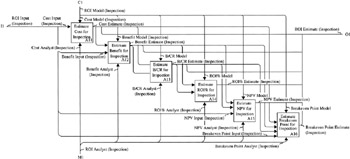7.5 Inspection NPV Methodology
The return on investment (ROI) methodology for the Software Inspection Process is a procedure to measure, quantify, and analyze its economic value. The Software Inspection Process is a type of meeting which is held in order to identify defects in software work products. ROI is the amount of money gained , returned, or earned above the resources spent on the Software Inspection Process. Its ROI methodology is a six-part process that consists of estimating costs, benefits, benefit/cost ratio (B/CR), return on investment percent (ROI%), net present value (NPV), and breakeven point. The ROI methodology for the Software Inspection Process has unique elements for estimating costs, benefits, and B/CR. Its cost and benefit methodologies are complex, though its B/CR, ROI%, NPV, and breakeven point methodologies are simple. Key elements include the total life cycle cost model, which is used to estimate the benefits of using the Software Inspection Process. Figure 25 illustrates the ROI methodology for the Software Inspection Process.

Figure 25: ROI Methodology for Software Inspection Process
7.1 Inspection Cost Methodology
The cost methodology for the Software Inspection Process is a procedure to measure, quantify, and analyze the amount of money spent. The Software Inspection Process incurs cost to find defects, but results in lower overall software maintenance costs. Cost is the economic consequence of using the Software Inspection Process to create a new and improved software process. Its cost methodology is a five-part process that consists of estimating training, software, meeting, test, and maintenance costs. The cost methodology for the Software Inspection Process has unique elements for estimating meeting and software maintenance costs. Its cost methodology consists of a complex composite of uniquely interrelated software cost and defect models. Key elements include the software, meeting, test, and maintenance cost models. These are used to approximate the complete costs of software development and maintenance, in conjunction with the Software Inspection Process. Figure 26 illustrates the cost methodology for the Software Inspection Process.

Figure 26: Cost Methodology for Software Inspection Process
Estimate training cost for inspection: The objective of this activity is to estimate all of the training costs for the Software Inspection Process. This substep includes: multiply training rate, participant, and effort for inspection and add training time and training fee cost for inspection.
Estimate software cost (baseline) for inspection: The objective of this activity is to estimate the costs of software analysis, design, and implementation. This substep includes: estimate software cost (Boehm) for inspection, estimate software cost (Walston/Felix) for inspection, estimate software cost (Bailey/Basili) for inspection, estimate software cost (Doty) for inspection, and estimate software cost (average) for inspection.
In this case, the outputs of the software cost models by Boehm, Walston/Felix, Bailey/Basili, and Doty were averaged together. This was done as sort of a Delphi method to arrive at an average software cost. The reader is free to substitute contemporary cost models, such as COCOMO II, PRICE-S , SLIM , Knowledge Plan , or any others, in order to accurately estimate software costs. The formulas for these models are illustrated in Chapter 5.
Estimate meeting cost for inspection: The objective of this activity is to estimate the cost for performing the Software Inspection Process. This substep includes: estimate meeting cost (BNR) for inspection, estimate meeting cost (Gilb) for inspection, estimate meeting cost (AT&T) for inspection, estimate meeting cost (HP) for inspection, estimate meeting cost (Rico) for inspection, and estimate meeting cost (average) for inspection.
The outputs of the BNR, Gilb, AT&T, HP, and Rico Software Inspection Process cost models were averaged together. Again, this was done as a Delphi method to arrive at an average Software Inspection Process cost. The formulas for these models are illustrated in the free Web Added Value TM materials available at www.jrosspub.com.
Estimate test cost for inspection: The objective of this activity is to estimate the cost of software testing based on defects escaping the Software Inspection Process. This substep includes: estimate starting defects for inspection, estimate meeting efficiency for inspection, estimate pre-test defects for inspection, estimate test efficiency for inspection, estimate post-test defects for inspection, and estimate test cost ( projected ) for inspection.
Estimate maintenance cost for inspection: The objective of this activity is to estimate the cost of software maintenance based on defects escaping the Software Inspection Process and testing. This substep includes: estimate total life cycle cost for inspection and estimate maintenance cost (projected) for inspection.
EAN: 2147483647
Pages: 145